When you think of Vietnamese food, what do you think of?
The only dish that I was remotely familiar with before quitting my job and moving to Vietnam for 3 months was Pho. Even with Pho, though, I’ve maybe had it twice in my entire life. I didn’t even know that it is traditionally a breakfast food!
In the blog post below, I detail my experience with Vietnamese food by region, starting with the south of the country, and moving to the north. Let’s dive right in.
Table of Contents
Hồ Chí Minh City
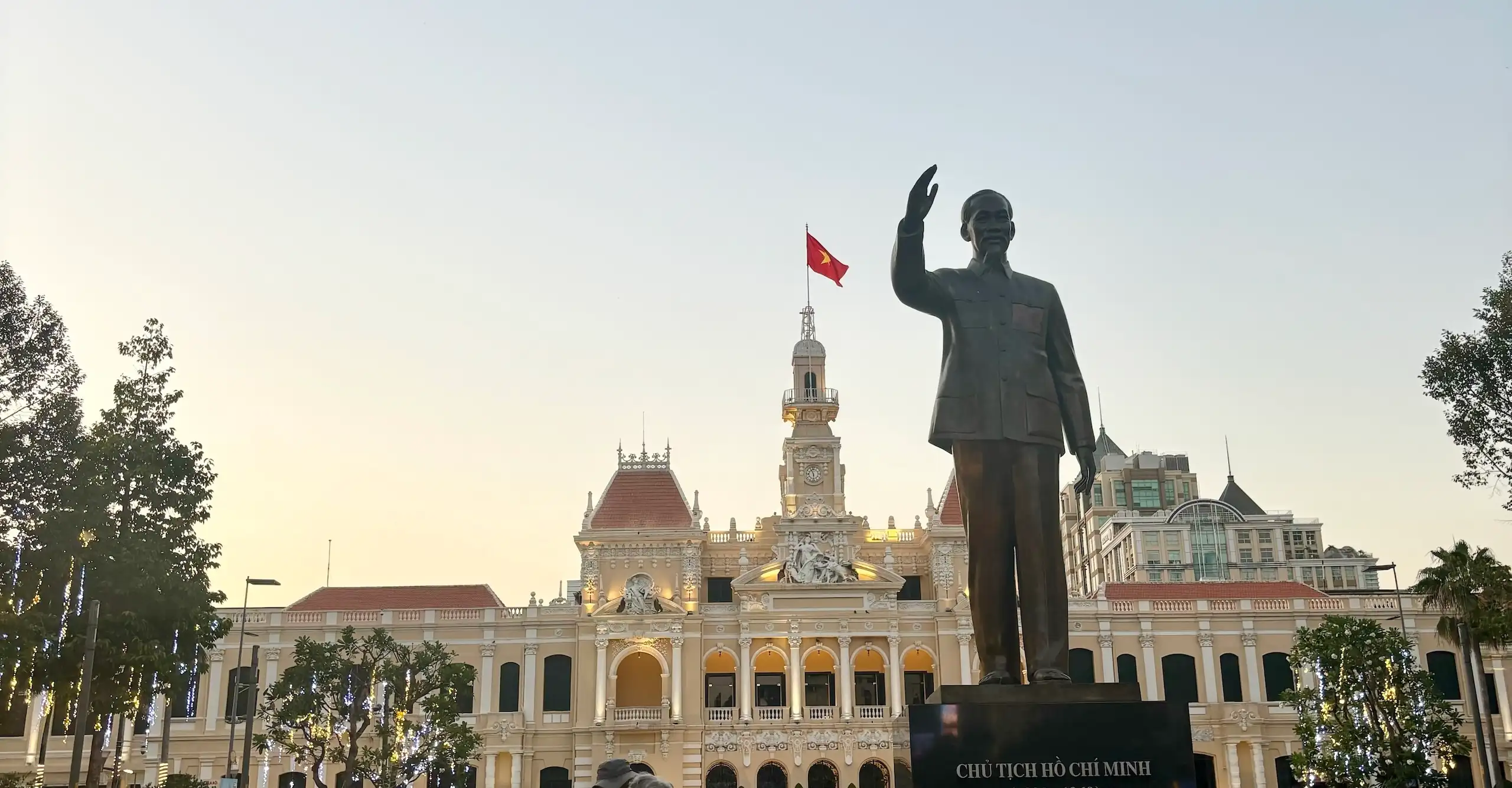
Ho Chi Minh City (HCMC), formally known as Saigon, is one of the most unique cities that I have ever been to. It is a giant metropolis, renowned for its diverse and delicious food scene, consisting of 24 diverse districts (I assure you, these are much more interesting districts than in the Hunger Games).
How big is Ho Chi Minh City?
Huge! Almost 9 million people call HCMC their home and it spans about 809 square miles. Compared to New York City, that has a population of 8.5 million people, 469 square miles, and you realize just how huge Ho Chi Minh City is. Add in about 7.3 million motorbikes, and you get one of the coolest (even though it’s wildly hot and humid haha) cities in Southeast Asia.
The city’s culinary landscape is a vibrant blend of traditional Vietnamese flavors and international influences, offering a wide array of dishes to satisfy any person. From alleyway street food stalls to three-dollar-sign restaurants, HCMC boasts a rich culinary heritage that showcases the best of Vietnamese cuisine.
What is phở?


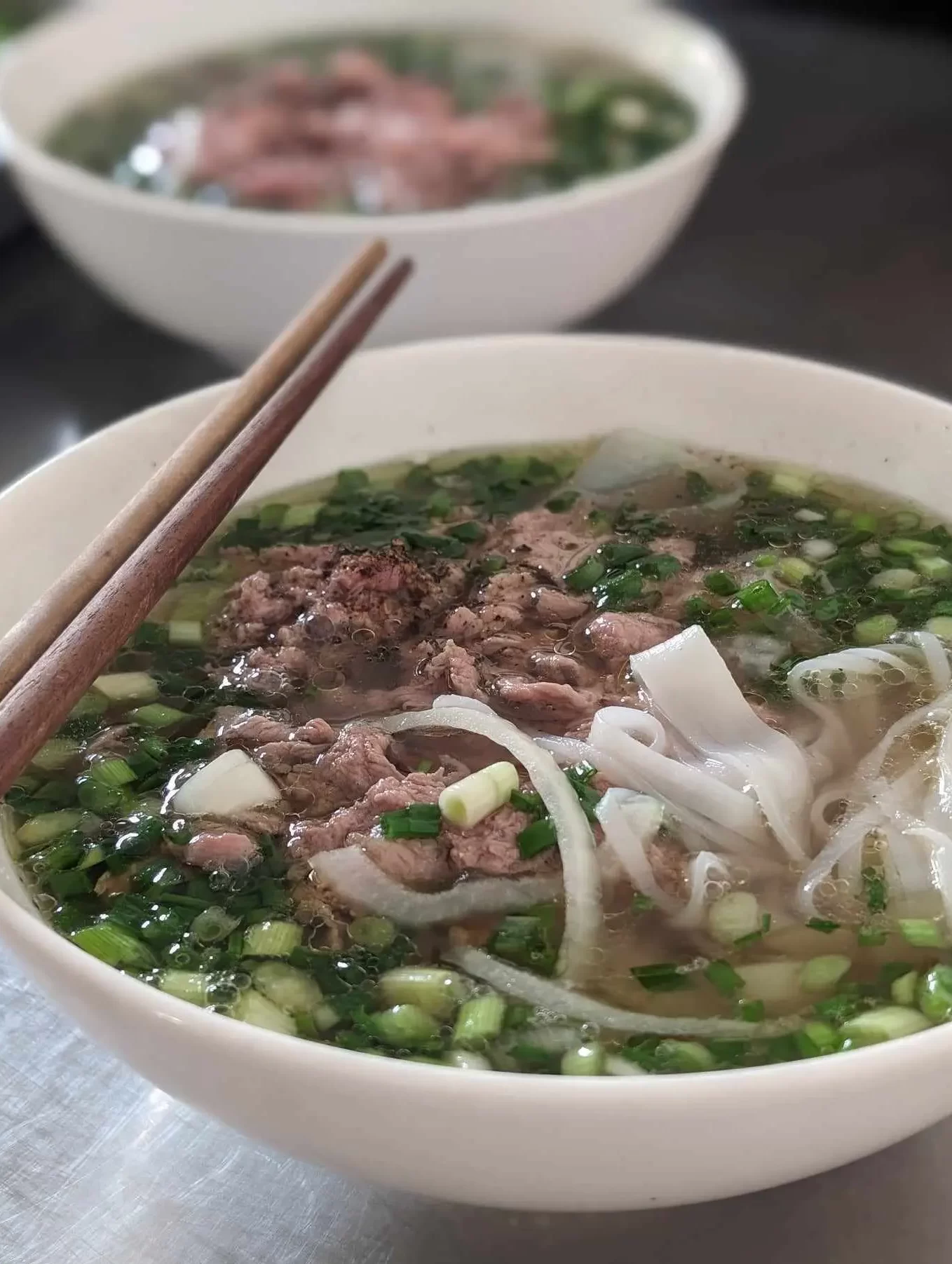
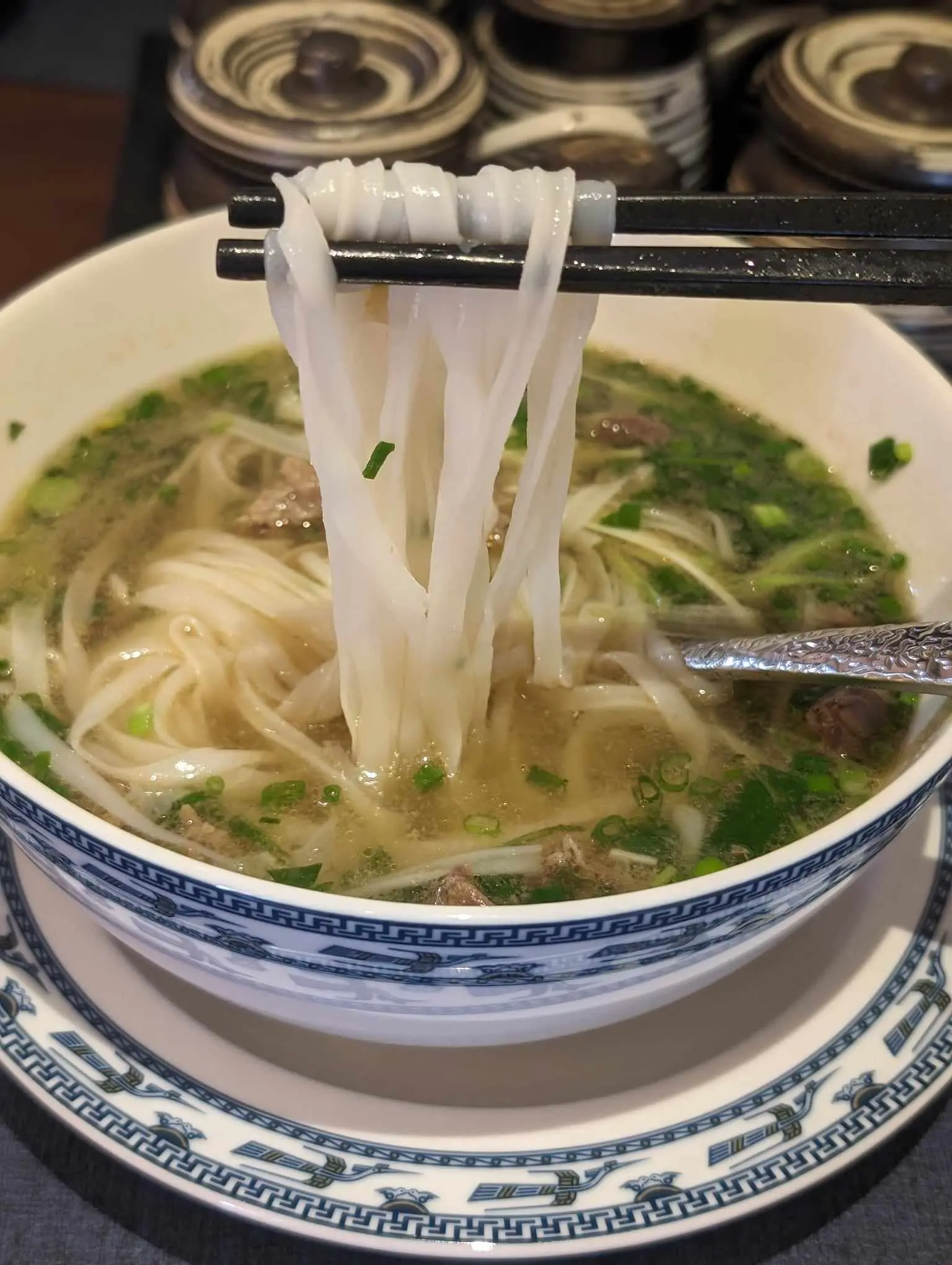
Pho is a traditional Vietnamese breakfast noodle soup that is known for its broth, rice noodles, and herbs. To enjoy pho, start by sampling the broth, which is often simmered for hours with spices like star anise, cinnamon, and cloves. Next, add fresh herbs like Thai basil, cilantro, and sawtooth herb, along with bean sprouts and a squeeze of lime to taste.
While traveling from southern Vietnam to northern Vietnam, I noticed that the further north you go, the less herbs you are provided with your soup orders. In Ho Chi Minh City, for example, our table was often given what can only be described as an entire bush of fresh herbs with each meal. However, in Hanoi, you often don’t receive any herbs on the side of your dish; they are typically already added to the soup.
What is phở tái?
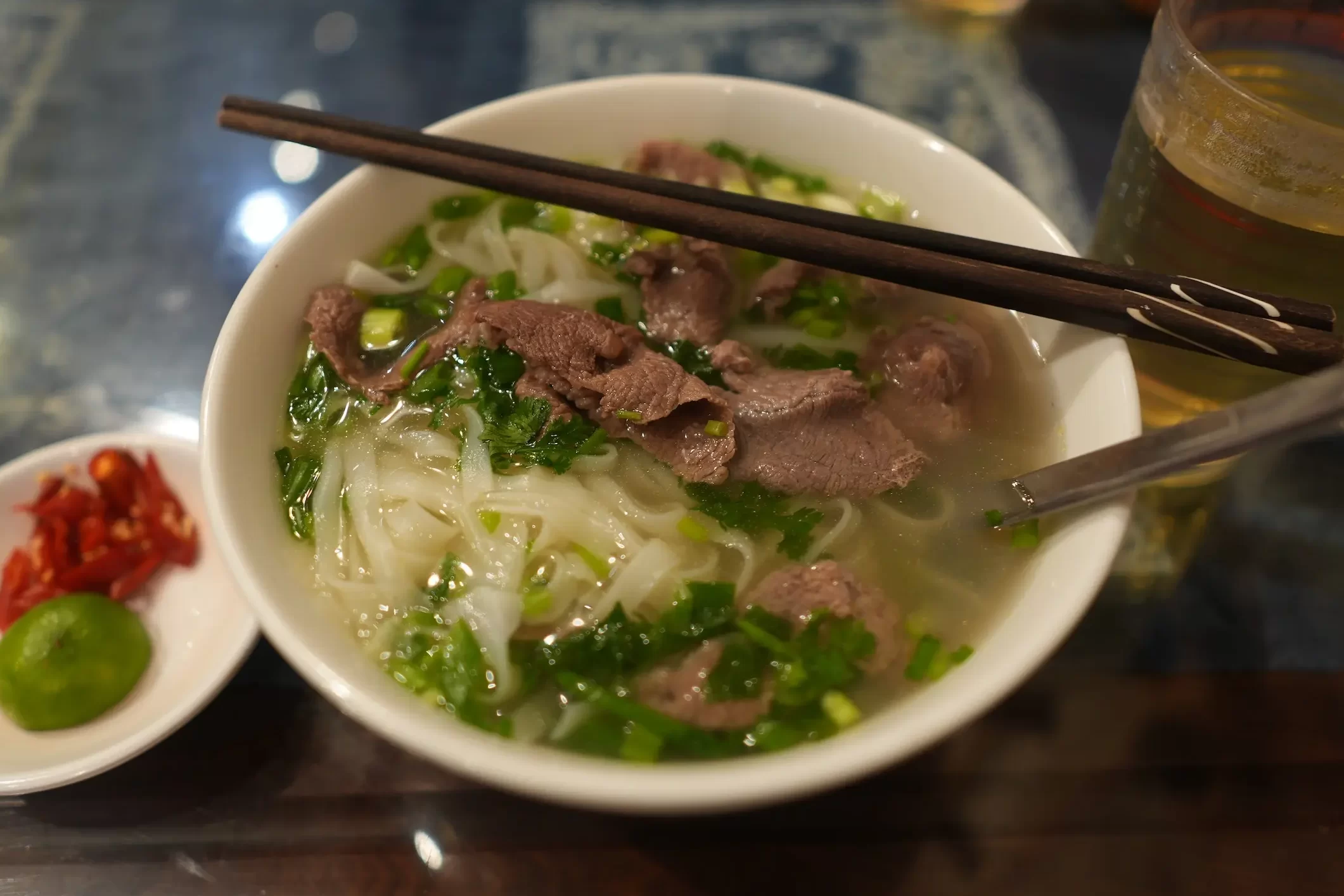
Pho tai, is pho with thinly sliced rare beef that, upon being added to the broth, cooks instantly in your bowl. This variation is my personal favorite, as it highlights the delicate flavors of the beef, adding a unique texture to the dish.
Other popular variations of pho include pho ga (chicken pho) and pho chay (vegetarian pho).
Best Places to Eat in Hồ Chí Minh City
When it comes to the food scene in Ho Chi Minh City, this is the place to go if you love food. When we visited, we stayed in the Thao Dien District 2 area of the city. There were numerous restaurants, cafes, and shops to explore. Our favorite restaurants in HCMC included:
- Phố Hàng Phở – Thảo Điền – Their stir-fried pho was delicious
- Kashew Cheese Deli – a fully vegan sandwich restaurant that has some of the best sandwiches on their menu
- Nhím’s Mama Bistro – a local gem with a small selection of rotating soups and other dishes each day
- Bánh Căn Bánh Xèo Cô Trang Đà Lạt – a family owned restaurant serving delicious Vietnamese pancakes
- 烤肉米線 (Bún thịt nướng, BBQ Rice Noodles) – I would compare this to an Asian Chipotle bowl, so, so, good!
Đà Nẵng

What is bánh xèo?
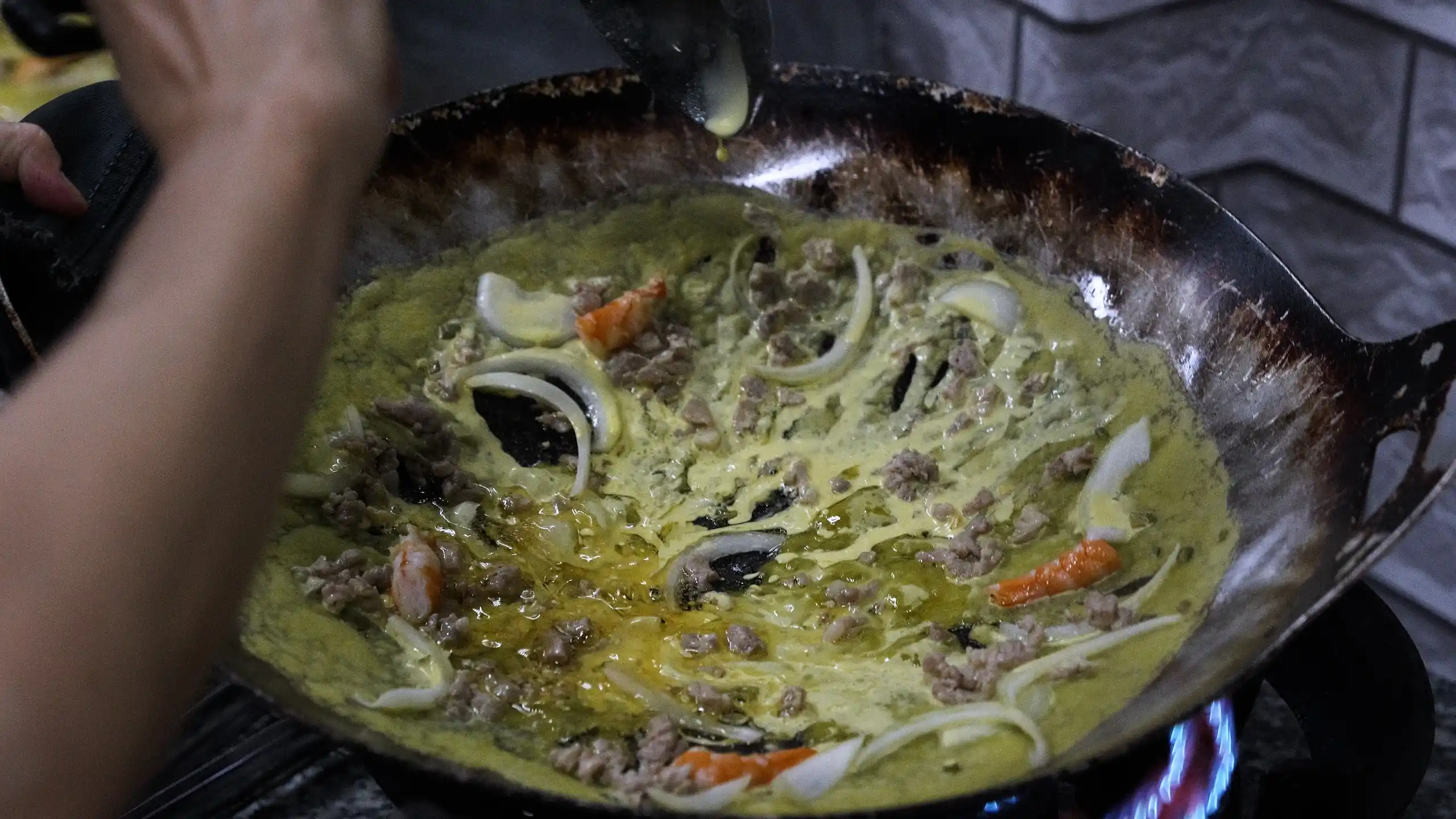
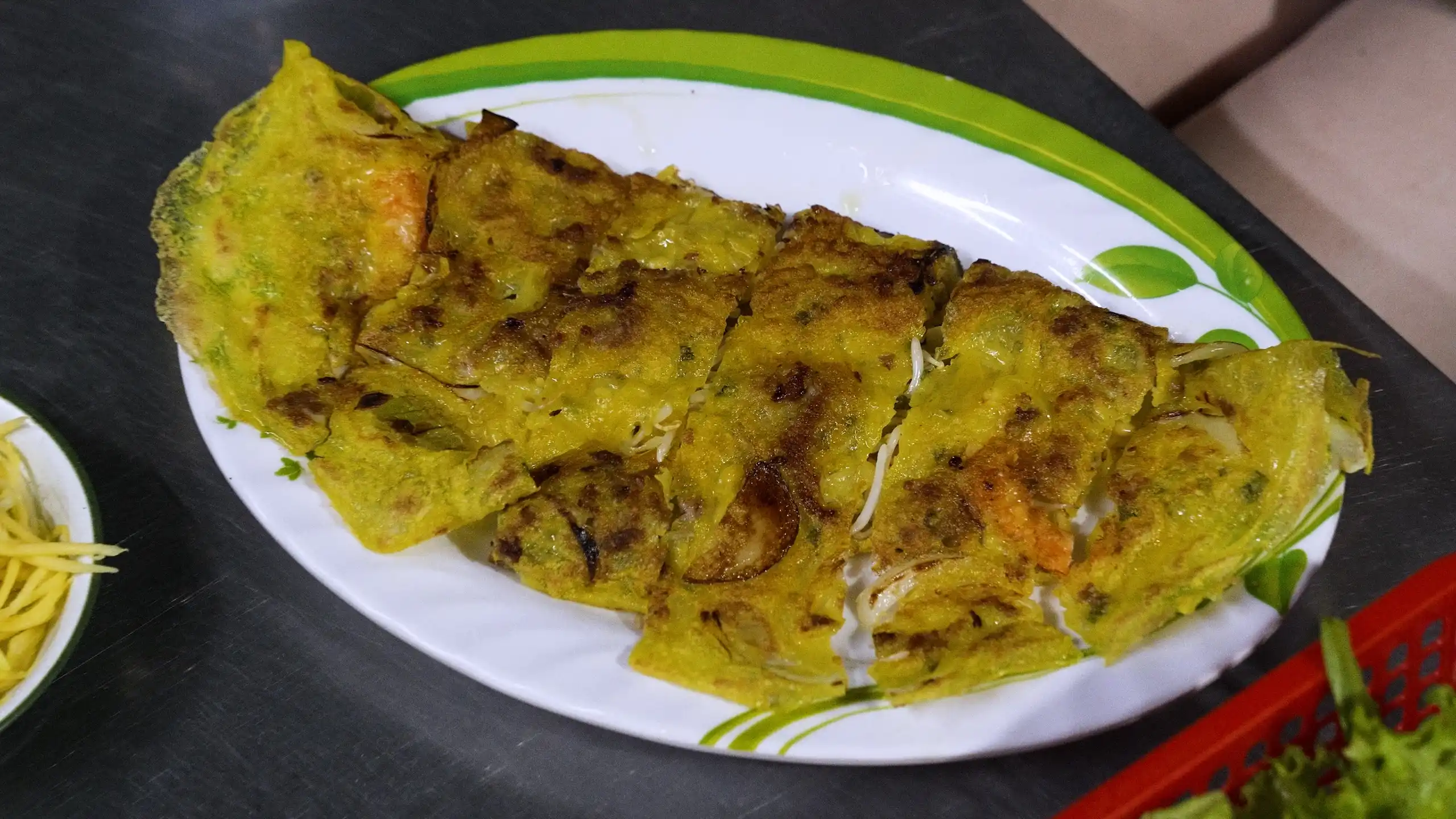
Banh xeo, a popular Central Vietnamese dish, is a savory crepe made from rice flour, coconut milk, and turmeric, giving it its distinctive yellow color. The name “banh xeo” translates to “sizzling cake,” which refers to the sound the batter makes when it hits the hot skillet.
The crepe is typically filled with a variety of ingredients, including shrimp, pork, bean sprouts, and green onions. It’s often served with a side of fresh herbs and lettuce, which are used to wrap the crispy crepe before dipping it in a sweet and tangy dipping sauce. Banh xeo is not only delicious but also a fun and interactive dish to enjoy with friends and family.
When I first saw this pancake in Ho Chi Minh City, I was convinced that it had eggs. To my surprise, I found out that there are no eggs in Ban xeo at all! The turmeric is what makes the batter yellow and look like an omelet.
What is mì Quảng?
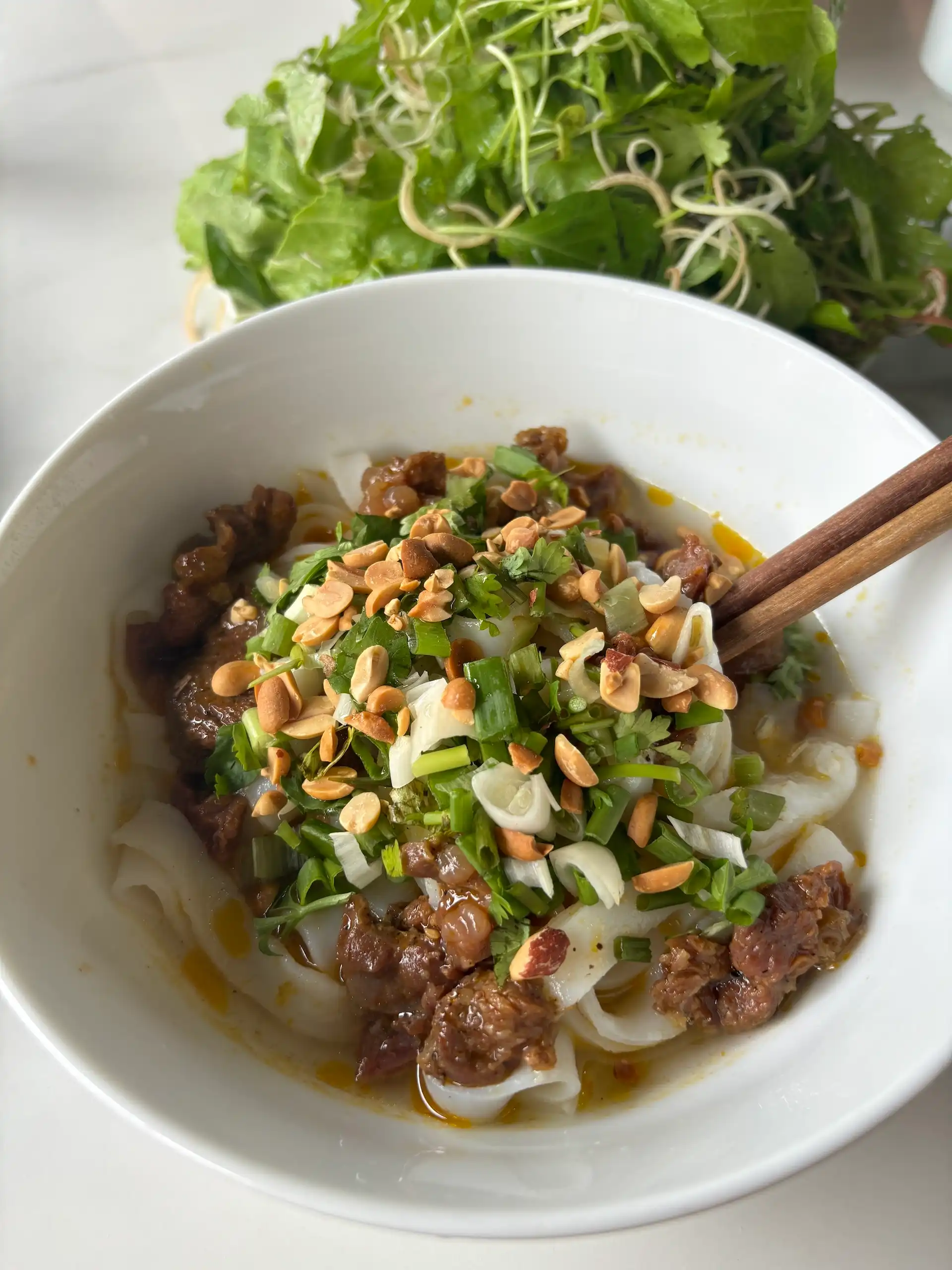
Mì Quảng, or “Quảng noodles,” (often pronounced me-wang) is a beloved Vietnamese noodle dish with roots in Quảng Nam Province, which is very close to Da Nang, in central Vietnam. It holds a special place in the region’s culinary culture, often enjoyed at family gatherings, during death anniversaries, and as a traditional dish for Tết, the Vietnamese Lunar New Year.
The dish consists of turmeric-infused rice noodles that have a satisfying bite. The noodles are surrounded by a very rich turmeric broth/sauce. Since the broth is so flavorful, there is typically much less of it in the bowl.
Best Places to Eat in Đà Nẵng
- Roots Plant-based Cafe – Vegan cafe close to the ocean, I loved getting the combo meal for breakfast
- Mì quảng MỸ SƠN 155 đỗ bá – fantastic my quang can be found here
- Hải sản Mộc quán Đà Nẵng – great seafood spot, come early to avoid long table wait times
Huế
What is bún bò Huế?
Bun bo Hue – the name itself provides a breakdown of its key components: “bún” refers to the round rice vermicelli noodles that form the base of the dish, while “bò” indicates the beef that is the primary protein in the soup. “Huế” signifies the dish’s origin in the historic city of Huế, known for its imperial past.
This iconic noodle soup is a testament to Vietnam’s culinary diversity, blending flavors and ingredients from different regions. It features a flavorful lemongrass broth, the result of hours spent simmering beef bones and lemongrass. Despite its name, bun bo Hue also includes pork bones and sausage.
When my partner Alex and I were planning our trip to Vietnam, we were determined to explore this city and try its famous soup. Bun bo Hue has easily become one of my top picks for Vietnamese cuisine. The broth strikes a perfect balance of rich flavor, citrusy hints, fresh mint, and basil. It’s safe to say, this dish has won us over:)
Check out my friend Tyler’s video about bun bo Hue:
What is rau muống?
Rau muống, or Morning Glory, is a plant that got its name from its behavior of blooming in the morning and closing by midday. This characteristic led to its association with the fleeting beauty of youth, as reflected in its name in Vietnamese, “rau muống.” The plant’s ability to thrive in various conditions and its quick growth also contribute to its symbolic meaning of vitality and resilience.
Morning glory is a staple vegetable in Vietnamese cuisine and is particularly popular in Huế. This leafy green vegetable is versatile and can be cooked in various ways, but one of the most common and delicious ways to prepare it is in a stir-fry.

The dish typically includes garlic, chili, and soy sauce, which add flavor and a bit of heat to the mild taste of the morning glory. The result is a simple yet flavorful dish that complements many Vietnamese meals. I love the garlic cloves that typically come stir-fried with the morning glory.
Best Place to Eat in Huế
- Bun Bo Hue O Phụng – best bun bo Hue I had while visiting the city
Hội An

What is a bánh mì?
Banh mi sandwiches vary across Vietnam, reflecting regional tastes and ingredients.
In Hanoi, the traditional banh mi typically includes pate, cold cuts, and pickled vegetables. It’s known for its simplicity and balance of flavors.
In Ho Chi Minh City (Saigon), banh mi tends to be more diverse and feature a wider range of ingredients. Saigon banh mi often includes additional fillings like grilled pork, fried eggs, and various sauces, reflecting the city’s multicultural influences.
In central Vietnam, banh mi often includes different types of savory fillings like nem lui (grilled pork sausage) and cha (pork meatloaf), along with fresh herbs and vegetables. The bread in central Vietnam is also slightly different, with a softer texture compared to the crustier baguettes used in other regions.
Overall, while the basic elements of banh mi remain consistent—a crispy baguette, savory fillings, pickled vegetables, and fresh herbs—the specific ingredients and flavors can vary significantly across Vietnam’s regions.
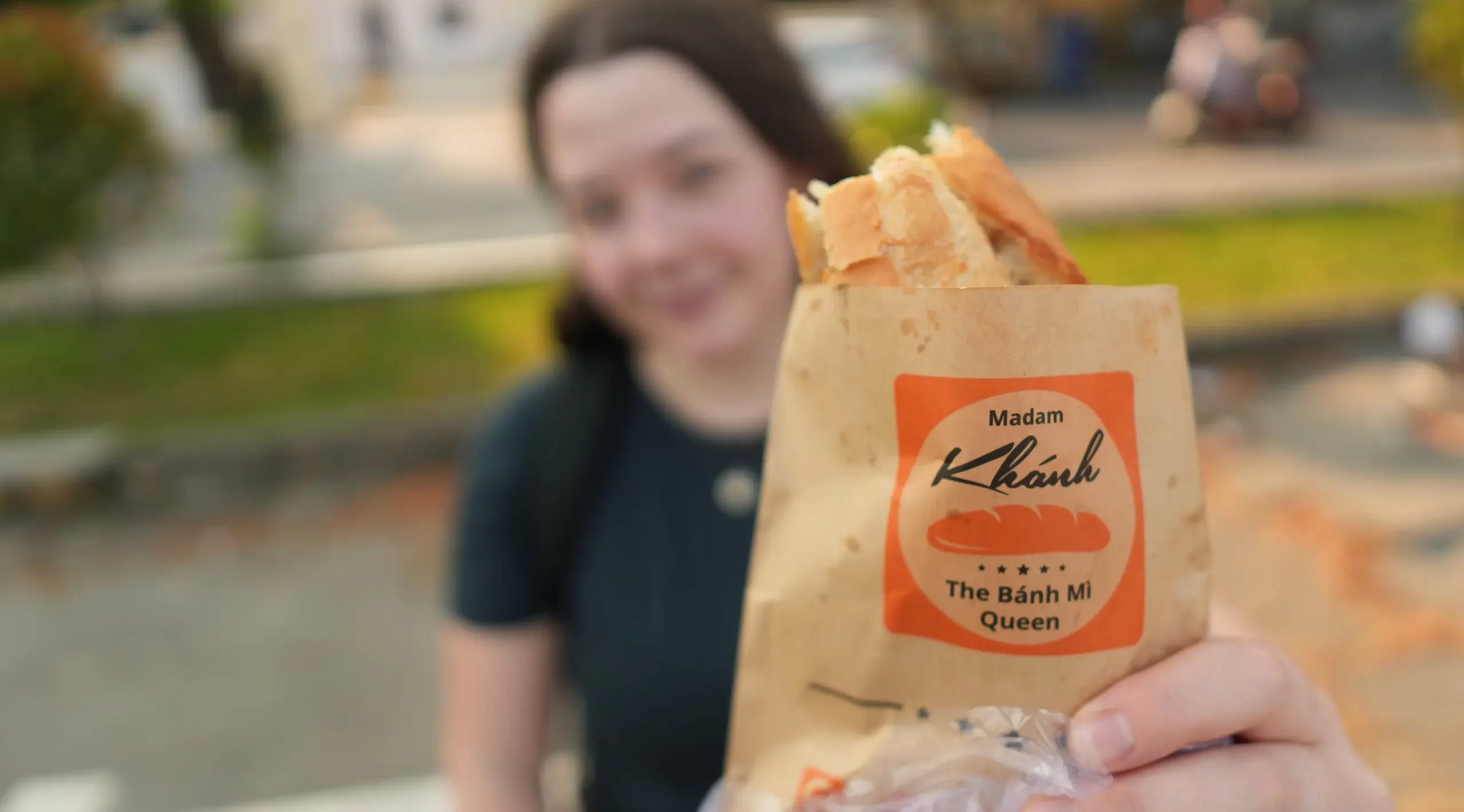
In Hoi An, the Banh Mi Queen cafe is a must-visit. This iconic eatery is known for its delicious and affordable (each one is about $2 USD) sandwiches. The Banh Mi Queen offers a variety of fillings, including grilled pork, chicken, tofu, and a range of fresh herbs and vegetables, all stuffed into a crispy baguette.
Personally, I absolutely loved this spot because of the meatier flavor of the banh mi. The owners have a commitment to using fresh, locally sourced ingredients, and since so many people visit, the ingredient turnover is also very high.
What is cao lầu?

Cao lau, loosely translates to high up, or top story of a building. In the days of Hoi An’s trading port, merchants who stopped in the city, wanted to eat where they could see their trading vessels, so they would ask to be seated on the top floor of the building. Hence, the dish’s name. This culinary gem emerged in 17th-century Hoi An, a time of thriving East-West trade that helped create a unique blend of flavors and textures.
Cao lau features signature noodles, Chinese char siu beef, and chewy textures similar to Japanese Udon. The noodles, crucial to its character, are made using water from Hoi An’s ancient wells, giving them a unique texture and flavor. The pork, typically loin or trotter, undergoes a meticulous process of marination, frying, and roasting, adding layers of flavor.
The broth, simmered with the same well water, adds a depth that is probably impossible to replicate on your own. To finish, fresh greens like mint, basil, and cilantro/coriander, along with crispy squares of Cao Lau dough, are added. Because of the specific well water-based noodles and broth, it is very difficult to find this dish anywhere in Vietnam, besides Hoi An.
Best Places to Eat in Hội An
- Madam Khanh – The Banh Mi Queen – please try these sandwiches, they are so good
- Chợ Hội An (Hoi An Market) – Hai Chiến Cao Lầu – stall E034
- Cơm Gà bà Thuận – CƠM GÀ (chicken and rice)
- White Rose Restaurant for some dumplings
Conclusion
This is by no means an exhaustive list of Vietnamese dishes and places to eat in Vietnam. However, I hope that it’s a good starting point. While traveling this wonderful country I have realized that it would be near impossible to gather a comprehensive list of all of the amazing food that Vietnam has to offer. So, think of this blog post as a challenge. What dishes would you add to the list?


2 comments
Mì Quảng is sooo good. I once had two bowls of it in one sitting. Can’t wait for my next trip to Vietnam!
It is so good! I love the noodles. Vietnam is the type of place you can’t visit just once:)